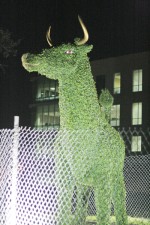Topiary bull purchase took time to grow

To many students and employees, it seemed like it happened overnight. They left for winter break, and up sprouted a towering mass of PVC pipe, galvanized steel and green moss — a larger-than-life Bull mascot.
Students commented on the Oracle Web site and USF message boards about its sudden existence — and its $27,000 price tag. Some University officials said they hadn’t heard of plans to create the topiary when asked about it Jan. 7, two days into the semester.
But it didn’t just grow up from out of the ground. And it wasn’t as easy as writing a check.
Like many University projects costing more than a couple thousand dollars, the topiary underwent a bidding process through USF’s Department of Purchasing. Nearly all items paid for by the University must go through the department, from boxes of whiteboard markers to the $65-million Marshall Student Center.
When it comes to receiving a purchase order — a statement authorizing a department or employee to use USF money to pay for something — the process differs depending on how much an item costs. Anything under $4,999 — like boxes of whiteboard markers, for example — requires verbal price quotes, which must later be documented, whereas items exceeding $75,000 require a formal bidding process, with the bids written and documented, according to USF’s competitive pricing statement on the purchasing department Web site.
Since the leafy mascot cost more than $25,000 but less than $75,000, it required at least three written price quotes, according to the pricing sheet.
If only one vendor can make the object or provide the service in question, or if it is an extension of an existing project, it may be exempted from this process, said USF Spokesman Michael Hoad.
One example of this was when the University hired a marketing company to research ways to brand USF Health to gain better name recognition.
“We’d often get an exemption so the company could do the second phase of the project, even though it’s technically a separate project,” he said. “It wouldn’t be fair to go to another company and let them use their (the original company’s) research that they conducted in phase one to complete phase two.”
Though topiary artists may not seem common, USF Facilities Management Vice President Joe Eagan wrote in an e-mail that the project did not file for an exemption that would allow for a single bidder.
Instead, a notice of bids was posted on the USF Department of Purchasing Web site. Depending on the project, the notice can be placed in the Florida Administrative Weekly or local newspaper ads, Eagan wrote.
When it’s time to consider the bids, purchasing department officials typically make decisions based on quality, service and delivery, according to USF Health’s purchasing section of its Web site. In the topiary’s case, concept design, previous work and price were major factors in the decision.
“While the artist chosen actually had the lowest cost of the proposals submitted, their selection was based on evaluation of construction technique and appearance from other examples of their work,” Eagan wrote.
Bids aren’t just a one-size-fits-all kind of deal, however. They can be issued in one of two categories: as a Request for Proposal (RFP) or Request for Qualifications (RFQ). The Bull topiary, for example, used an RFP, Eagan wrote, which is essentially an invitation to suppliers to submit what they think it’d cost to complete a project.
Conversely, an RFQ contains the minimum qualifications of the supplier, along with project requirements, selection criteria and a statement outlining the scope of the work.
Sometimes, though not in the topiary’s case, the purchasing department uses a method of sealed bids — price quotes for completing the project that are kept secret from competitors until the bidding deadline has passed. All of the bids are opened at the same time to avoid any perception of impropriety, Eagan wrote, and are used when the department deems appropriate.
Once the bidding period has ended, Florida state statutes require the purchasing department to post its bid tabulations publicly, leaving bids open for 72 hours after review. Contracts costing less than $200,000 — like the mossy mascot — may be exempted from needing a performance bond, according to State Statute 255.05. Insurance companies issue such bonds, which protect the University from loss should a vendor be unable to complete a project.
Also serving as a means of checks and balances for the department, the vendor ombudsman hears complaints about University payment issues and acts as an advocate for bidders, according to the Terms and Conditions listed in the Invitation to Bid.
Once a bid is accepted, the purchasing department issues a purchase order to the person or group of people who requested it. From there, the vendor may begin work until one day, a foliage-covered Bull appears — or whatever the project may be.






